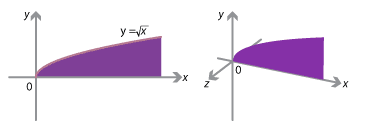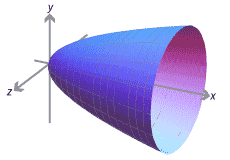Links forward
Integration and three dimensions
So far we have used integration to calculate areas, which are 2-dimensional. Integration can also be used to obtain 3-dimensional volumes.
For instance, take a graph \(y = f(x)\) in the \(x–y\) plane, and consider adding a third dimension: points in 3-dimensional space have coordinates \((x,y,z)\), and there is now also a \(z\)-axis. The figures below show the graph of \(y = \sqrt{x}\), for \(0 \leq x \leq 5\), in the plane and then adding a \(z\)-axis.

Detailed description of diagrams
We can now consider rotating the curve around the \(x\)-axis. As we do, the curve sweeps out a surface, and the area under the curve sweeps out a 3-dimensional solid. The solid has rotational symmetry about the \(x\)-axis and is called a solid of revolution.

We can estimate the area under the graph \(y=f(x)\) in the plane by subdividing the \(x\)-interval and forming rectangles. Rotating these rectangles about the \(x\)-axis, we estimate the volume of the solid of revolution by cylinders.

Detailed description of diagrams
Use our usual notation: we consider the graph of \(y=f(x)\) between \(x=a\) and \(x=b\), and we divide the interval \([a,b]\) into \(n\) subintervals \([x_0, x_1]\), \(\dots\), \([x_{n-1}, x_n]\) of width \(\Delta x\). As we have seen, for the right-endpoint estimate, the rectangles have width \(\Delta x\) and height \(f(x_j)\), and hence area \(f(x_j) \; \Delta x\). Similarly, the cylinders have radius \(f(x_j)\) and width \(\Delta x\), and hence volume \(\pi \, f(x_j)^2 \, \Delta x\). We can estimate the volume of the solid of revolution as \(\sum_{j=1}^n \pi \, f(x_j)^2 \, \Delta x\). Taking the limit as \(n \to \infty\), the volume of the solid of revolution is
\[ \int_a^b \pi \, f(x)^2 \; dx. \]More generally, if we have a solid bounded by the two parallel planes \(x=a\) and \(x=b\), and at each value of \(x\) in \([a,b]\) the cross-sectional area of the solid is \(A(x)\), then the volume of the solid is
\[ \int_a^b A(x) \; dx. \]Using this idea, it's possible to derive the formulas for the volumes of pyramids, prisms, and other solids. In higher mathematics courses one studies 3-dimensional (and higher-dimensional) volumes using multiple integrals.
